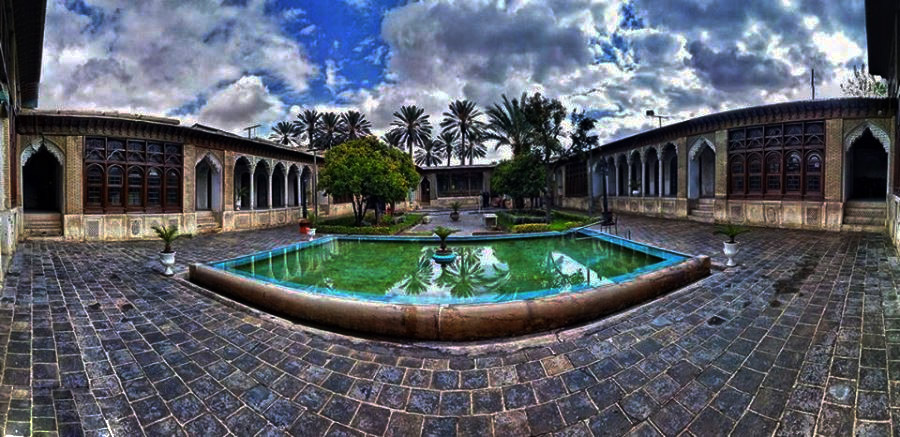Introduction to the Zinat al-Muluk House
Shiraz is a city of poetry, literature, and the aroma of spring orange, full of historical and natural attractions such as Zinat al-Muluk house with warm-blooded people. The people who are well-known for their culture, generosity, and wisdom. Some of them are relics, and some of them are poetry, some of them have done great things, and some of them have left occult books as a memento. In the city, some properties of great people are left to picture their life.
One of the Qajar houses is the house of Zinat al-Muluk. This house was actually the inner part of Ghavam’s house, which was connected to the outer of Ghavam’s orange Garden through an underground tunnel. This tunnel was built to provide security for the passage of the residents of the house between Ghavam Garden and Zinat Al-Molk House. These two monuments form the Ghavam complex, which is a relic of the time of Nasser al-Din Shah, Qajar king.
History of Ghavam-ol-Molk family and the House
The Ghavam-ol-Molk family is from the Etemad al-Dawla generation of Shiraz, who were the governors of Shiraz in different periods. In 1290 AH, an order was given to build a house with the style of Qajar houses. Mohammad Khan Ghavam-ol-Molk II undertook the construction of this building, and after about 10 years, it was finally completed by Mohammad Reza Ghavam-ol-Molk III. This house is called Zinat al-Mulk because of the residence of the daughter of Ali Mohammad Khan Qawam (Qawam al-Mulk IV). Zinat al-Mulk Ghavami was a very good woman who held vows and charitable gatherings on various occasions and lived in this house for many years.
The remarkable point in this building is that in 1980, during the Iran-Iraq war, this house was a haven for the people. In 1995, Fars Gallery started its activity in the basement of this house. In this gallery, the works of artists from Fars, Iran, and other countries were exhibited, and now it is dedicated to the title of Museum of Persian History.

Architecture of Zinat al-Muluk House
In the architecture of Zinat-ol-Molk house, Iranian style such as interior, exterior, porch, pool, etc. has been used. Next to the entrance, there are two mosaic living platforms with a height of 70 cm. Two Qajar soldiers with weapons are also standing next to these platforms. After crossing the octagon, he reached a courtyard full of beautiful flowers, around which stone carvings were carved and latticed, and in the middle of which there was a stone pool. Also, carefully in the main mansion, you will notice seven-color tiles with the image of two angels, the sun, a sword in hand, and verses of the Quran, which have doubled the beauty of the mansion.
Internal Design of Zinat al-Muluk House
Zinat al-Muluk House has more than 20 rooms with wooden roofs, all of which have access to each other. The plastering of pillars and walls, paintings of animals, flowers, and plants, dazzling designs, and exquisite mirror work are among the things that could be seen in this Qajar house. The presence of colorful glasses in the windows when the sun shines causes a dazzling reflection of light on the doors and walls, which creates an attractive and pleasant atmosphere.
In some rooms, you can see images of European women and children, which shows the influence of European art and architecture on Qajar decoration. In the main hall of the house, the ceiling of the hall and the mirror room have been decorated with pieces of mirrors. The large window of this hall includes stunning colored glass faces the courtyard, which the owner of the house would have been spelled with the enchanting dance of lights in the evenings.
Museum of Fame
The Museum of Fame is located in the basement of this historic house, and upon entering this section, you will be welcomed by the statue of Ms. Zinat al-Mulk guarding with the two statues of the Qajar soldiers. In this museum, you will see the historical course of the coverings of the ethnicities. This historical journey begins with the Achaemenid period when you can see the statue of Xerxes along with the Crown Prince, the head of ceremonies, and other people present in the parliament.
Statues of celebrities such as Saadi Shirazi, Barbod musician, Qaani Soortgar Shirazi, Babakohi, Mulla Sadra Shirazi, Vesal Shirazi, Qutbuddin Shirazi, Mohammad Namazi and many other prominent personalities of different periods, along with descriptions about them could be seen.
One of the most spectacular parts of the museum is the status of Persian nomads, including a young woman weaving in tribal costumes. Finally, the journey of the Museum of Fame ends with the statue of Martyr Abbas Doran.

